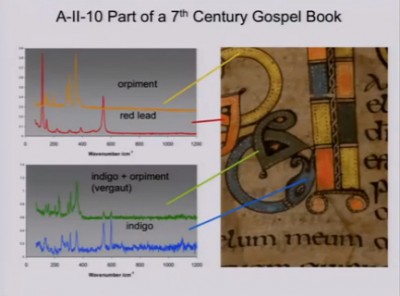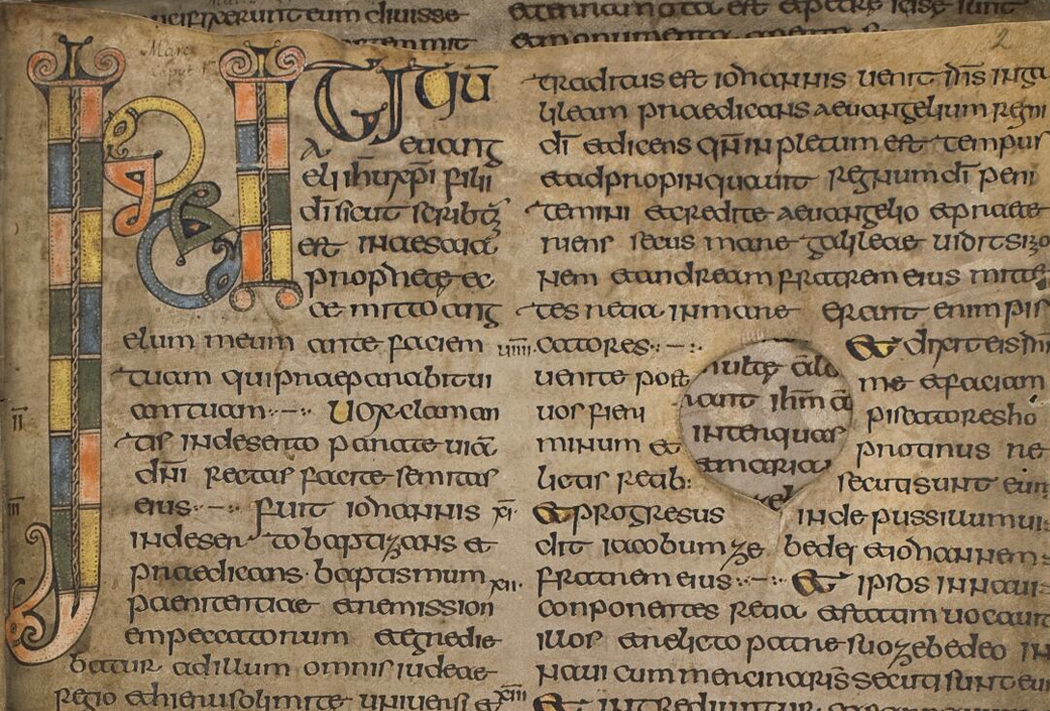Identifying pigments in medieval manuscripts gives an insight into the technical expertise of artists and sometimes trade-routes. Raman spectroscopy makes it possible without sampling
 Identifying the materials used in medieval illuminated manuscripts gives us an insight into the techniques and skills of the scribes and illuminators, as well as the occasionally complex trade routes of the times.
Identifying the materials used in medieval illuminated manuscripts gives us an insight into the techniques and skills of the scribes and illuminators, as well as the occasionally complex trade routes of the times.
The challenge is to be able to identify materials on a delicate sheet of parchment, typically a folio of a bound manuscript that does not open readily, without contact, sampling or causing any damage. Ideally the technique should give an unequivocal identification of pigments with high spatial resolution and selectivity.
One such technique is Raman spectroscopy. Applying this, the sample is illuminated with a single colour of light produced by a laser, and the light scattered from the sample is collected and analysed using a spectrometer. The scattered light contains a small fraction of light where the wavelength, corresponding to the colour, has changed. The Raman spectrum is the pattern of this change in wavelength and provides a unique fingerprint of the pigments.
Naturally, the technique has been both refined and optimized since its first discovery by the Indian physicist, Chandrasekhara Venkata Raman, who was honoured with a Nobel Prize 1930 for his discovery. Interestingly, some of its first uses were in fact to identify colours in Medieval illuminated manuscripts.
At Durham Andrew Beeby and his colleagues are currently studying the pigments used in manuscripts produced in the British Isles and northern Europe between the 7th and 15th centuries. By studying books of well-established provenance and time and place of origin he is currently building a map of pigment use, creating a valuable resource for conservators and historians. The changes in pigment choice and use reflect changes in technology transfer, e.g. as book production moved from the monastic to the secular, and of societal change, e.g. the changes in pigment use arising from the Norman conquest.
Elsewhere in Europe other groups of chemists are working on other medieval manuscripts. For instance a group in Portugal has worked to study Medieval Cistercian 12–13th century manuscripts: Santa Maria de Alcobaça, Portugal, while a third group in Belgium has experimented with using a transportable Raman spectrometer directly on location in the library.
Professor Andrew Beeby will continue to present his research in scientific contexts in the near future. But he is also scheduled to give a lecture at the upcoming Festival for British Archaeology on “Shining Light on Medieval Illuminations: Pigments through the Ages”, where he will explain this rather complicated technology to mere mortal archaeologists and medievalists.
Luckily the presentation was recorded on video. It has now been uploaded to youtube and anyone interested in this important though esoteric technique and its possibilities can get a feeling for what it can accomplish. It is really not difficult to understand – even for humanists.
SOURCE:
Shining Light on Medieval Illuminations: Pigments through the Ages
READ MORE:
There is a dedicated ‘Journal of Raman Spectroscopy’, which occasionally publish article on the use of the technique in connection with studies of medieval frescoes, illumination and other medieval art forms. In december 2014 a special issue on ‘Raman in Art and Archaeology 2013’ was published.
FEATURED PHOTO:
Note how the yellow color was used not only in the initial, but also to fill out some of the letters in the actual text. This color has been identified by Professor Beeby as orpiment, a deep orange-yellow colored arsenic sulfide mineral, which the monks must have imported from Italy (perhaps Vesuvius).
